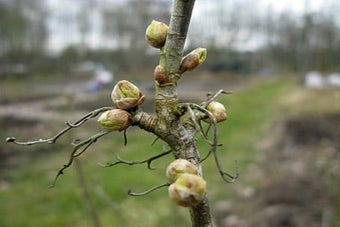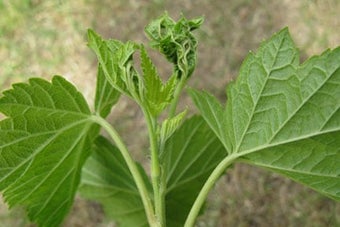
Quick facts
Common name - Currant and gooseberry leaf spot
Scientific name - Drepanopeziza ribis (syn. Pseudopeziza ribis)
Plants affected - Currants and gooseberries
Main symptoms - Leaf spots, premature leaf fall
Caused by - Fungus
Timing - Early summer
What is currant and gooseberry leaf spot?
This disease, which is caused by the fungus Drepanopeziza ribis (syn. Pseudopeziza ribis), can affect black, red and white currants and gooseberries and also occurs occasionally on ornamental Ribes species.
Symptoms
The first symptoms appear on the leaves in early summer (usually about June):
- Leaves become spotted with very small, dark brown or black spots
- Later, the spots become more numerous and often coalesce so that large areas of the leaves turn brown
- Large numbers of minute fungal spores form in fruiting bodies on these spots and may sometimes be visible as small droplets on the surface of the spots
- When the disease is severe, the leaves fall and the bushes may become defoliated by early July
- Sometimes the fruit shrivels before ripening

Control
Non-chemical control
- Rake up and dispose of (bonfire, consigning to or burying deeply) fallen leaves in order to prevent spring infection
- Diseased bushes should be well fed (Growmore at a rate of 70g per sq m or 2oz per sq yd). Where severe defoliation has occurred, it is probably worthwhile spraying developing leaves with a foliar feed such as Maxicrop, Miracle-Gro or Phostrogen the following season to enhance early growth
- bushes grown on light soils with a 5-7cm (2-3in) layer of garden or leafmould to conserve moisture, and water them in dry periods before the soil dries out completely. Rotted manure is ideal for blackcurrants, which have a higher nutrient requirement
- Bushes on light soils may need watering every 14 days in dry periods in summer
Some cultivars show some resistance:
Blackcurrant ‘Ben Connan’ AGM
Blackcurrant ‘Big Ben’
Blackcurrant ‘Black Reward’
Blackcurrant ‘Ben Gairn’ (also resistant to reversion virus)
Blackcurrant ‘Ben Hope’
Redcurrant ‘Rondom’
Chemical chemical
No fungicides are currently available to gardeners for control of this disease.
Biology
The fungus overwinters on fallen leaves in the form of fruiting bodies, which can withstand severe winter conditions. The following spring these structures produce spores of a different type from those formed on the plant in the summer. These spring spores attack the young leaves to start the infections for that season. Once the disease is present on the bush, it is spread further by the rain-splashed summer spores produced on the leaf spots.
Leaf spot is usually most severe on weak bushes, and the premature leaf fall reduces their vigour still further. The disease is also often troublesome on bushes growing in light soils.







